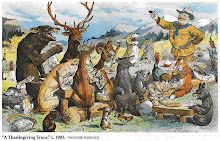Wolf-related research continues at Colorado ranch
Long-term study includes camera monitoring, tracking, DNA testing
While some scat samples found on The High Lonesome Ranch in northwestern Colorado have not tested positive for wolf DNA, research efforts continue on the original ecological assessment of the ranch that first lead to discovery of wolf sign on the property.
According to the DNA report just released by the Robert Wayne Lab at UCLA, "The fact that we were unable to amplify…DNA product in many of the samples… indicates that the DNA in these samples was significantly degraded. Our experience with even fresh canid scat samples is that 10-40% of samples may not yield amplifiable DNA from the individual of origin," said the report. Some of the samples were found to be of coyote origin.
The majority of the scat samples contained DNA that was not fully amplifiable because of the degraded specimen condition. The scats were collected at different times and were of different ages. The condition of the scat could have been affected by environmental conditions, as well storage and shipping.
The ranch's chairman and CEO, Paul R. Vahldiek, Jr., who initiated the original ecological assessment of this property, says research will continue to investigate a die-off of aspen groves on his land. As in other parts of Colorado, aspen on The High Lonesome Ranch show evidence of Sudden Aspen Decline, which is related to a variety of factors including climate change, disease, and excessive browsing by elk.
Regular measurements of aspen regeneration, changes in movement of elk herds and their behavior, and remote camera installations will also aid the study, which researchers say can expand the understanding of "trophic cascades" -- the domino effect that top predators have on plant and animal communities. A lack of keystone predators, like wolves, has been linked to over-browsing of aspen saplings by elk herds in the western U.S.
"These DNA tests are a valuable snapshot in time, but they represent only a small part of our ongoing research," said Vahldiek, who indicated that he was not surprised that some of the specimens tested positive for coyote. The ranch owner noted that he planned on continuing a full scientific assessment of his lands, headed by Cristina Eisenberg, a conservation biologist at Oregon State University specializing in predator prey interactions. "We will continue to use the best possible science to be good stewards of this land, and that will involve looking more deeply at scientific issues related to the land and its flora and fauna," said Vahldiek.
The DNA results do not necessarily mean that wolves are not present, due to continuing, reliable wolf sign collected by expert trackers on the ranch, including tracks and howling. Future research will include further DNA testing of scat samples and measurement of baseline aspen health for comparison with future conditions that might occur as a result of changes in carnivore populations.
Another member of the ranch's science team, Michael Soulé, a founder and board member of the Wildlands Network – a conservation group working to restore a network of wildlife corridors between Canada, the U.S., and Mexico – remains optimistic that wolves will naturally return to their former range in the southern Rockies. "The restoration and protection of safe landscape connections across the West, in places like the High Lonesome Ranch, will play a major role in allowing wolves to return in the future," says Soulé, "thus rehabilitating native ecosystems."
According to Wildlands Network Executive Director, Margo McKnight, the focus on the possible natural return of wolves to Colorado presents an excellent opportunity to think about wolf recovery in a different way. "We're confident that the lessons learned from other recovery efforts will help to create a Colorado plan that allows wolves and ranching to co-exist to the benefit of both," she notes. "Now is the time to consider a new approach to restoring ecological relationships in Colorado," she says, "even before wolves officially take up residence."
Wildlands Network P.O. Box 5284, Titusville, FL 32783 | info@wildlandsnetwork.org
Subscribe via email to get updates
Subscribe to:
Post Comments (Atom)










2 comments:
awesome blog, do you have twitter or facebook? i will bookmark this page thanks. lina holzbauer
Lina................scroll down the blogg and you can find us on facebook and twitter...............
Post a Comment